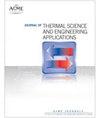Flow and conjugate heat transfer of swirl chamber with micro-ribs in turbine vane leading edge
IF 1.4
4区 工程技术
Q3 ENGINEERING, MECHANICAL
引用次数: 0
Abstract
Swirl cooling can provide effective protection for the turbine vane leading edge (LE). In this paper, a swirl cooling model for improving the turbine vane heat transfer is established. The model includes the high-temperature mainstream region, LE region, and swirl cooling region. The conjugate heat transfer (CHT) method is used to examine the influence of wall structures on swirl cooling. Then, the best surface structure in the studied range is selected to further analyze the impact of the coolant inlet mass flow. The results show that the circumferential micro-ribs structure has a more excellent performance in both fluid flow and cooling performance. The hindering effect of the micro-ribs can effectively avoid the development of axial cross-flow, thus enhancing the heat transfer with a small friction loss increment and providing a lower surface temperature and more uniform temperature distribution. When the inlet mass flow rate improves, the thermal performance factor increases and the LE temperature decreases gradually. Under the same pumping power condition, the circumferential micro-ribs structure has higher heat transfer efficiency. This investigation can provide a new design for further improving the thermal performance of swirl cooling for turbine vanes.涡轮叶片前缘微肋旋流室的流动与共轭换热
旋流冷却可以为涡轮叶片前缘提供有效的保护。本文建立了改善涡轮叶片传热的旋流冷却模型。该模型包括高温主流区、LE区和旋流冷却区。采用共轭传热方法研究了壁面结构对旋流冷却的影响。然后,选择研究范围内的最佳表面结构,进一步分析冷却剂进口质量流量的影响。结果表明,周向微肋结构在流体流动和冷却性能方面都具有更优异的性能。微肋的阻碍作用可以有效地避免轴向交叉流的发展,从而以较小的摩擦损失增量增强换热,提供更低的表面温度和更均匀的温度分布。随着进口质量流量的增大,热工性能系数增大,LE温度逐渐降低。在相同泵送功率条件下,周向微肋结构具有较高的换热效率。该研究可为进一步提高涡轮叶片旋流冷却热性能提供新的设计思路。
本文章由计算机程序翻译,如有差异,请以英文原文为准。
求助全文
约1分钟内获得全文
求助全文
来源期刊

Journal of Thermal Science and Engineering Applications
THERMODYNAMICSENGINEERING, MECHANICAL -ENGINEERING, MECHANICAL
CiteScore
3.60
自引率
9.50%
发文量
120
期刊介绍:
Applications in: Aerospace systems; Gas turbines; Biotechnology; Defense systems; Electronic and photonic equipment; Energy systems; Manufacturing; Refrigeration and air conditioning; Homeland security systems; Micro- and nanoscale devices; Petrochemical processing; Medical systems; Energy efficiency; Sustainability; Solar systems; Combustion systems
 求助内容:
求助内容: 应助结果提醒方式:
应助结果提醒方式:


